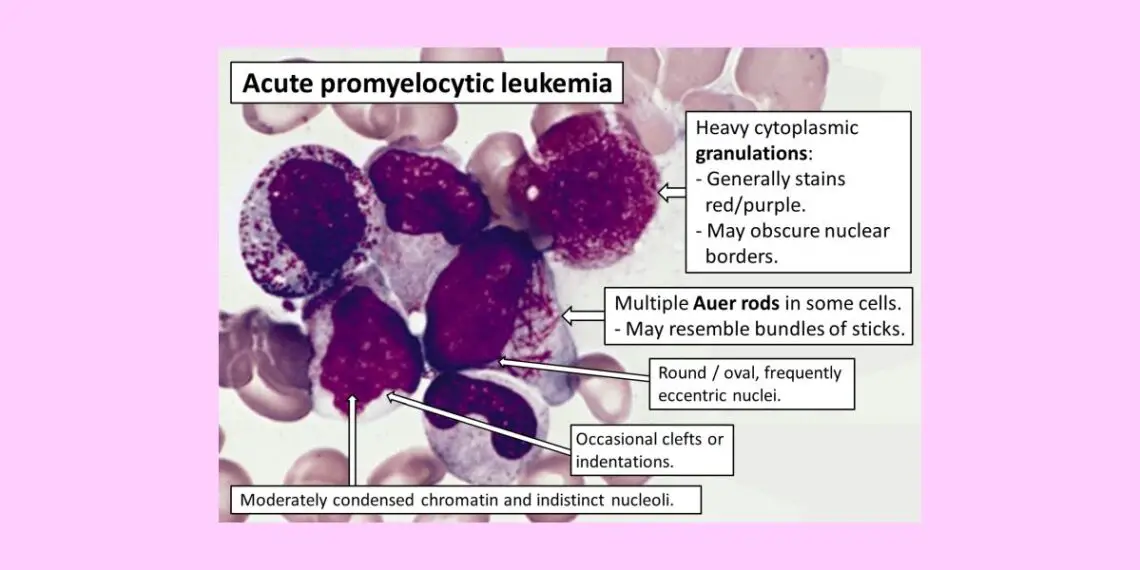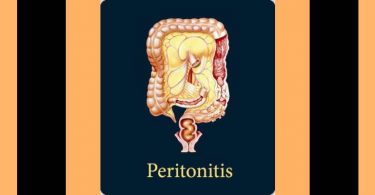Acute promylocytic leukemia is a biologically distinct form of acute myeloid leukemia that is characterized by a translocation between chromosomes 15 and 17. This results in a fusion protein between the genes encoding the retinoic acid receptor and the transcription factor promylocytic leukemia, which halts myeloid cell development at the promylocytic stage. These cells are commonly filled with granules, and auer rods are common microscopically, release of granules is clinically important, as they may cause disseminated intravascular coagulation in a patient who is already pancytopenic.
Clinical features and diagnosis of acute promylocytic leukemia
Usually the first symptoms of acute promylocytic leukemia are consequences of bleeding diathesis. Hemorrhages of the skin and mucosa prompt physicians to perform a hemogram. Sometimes severe hemorrhage leads to early death. Usually, no tumor, bone pain, adenopathy, or splenomegaly or hepatomegaly are recorded. Patients with acute promylocytic leukemia share many of the symptoms of acute non-lymphocytic leukemia, such as pallor, fatigue, weakness, palpitations, dyspnea on exertion, and fever.
In contrast to other subtypes of leukemia, in the hemogram, the majority of patients have total white blood cell count less than 5×10⁹/L. marked thrombocytopenia is usually found. The anemia is variable, often related to hemorrhage. However, about 5% of patients, usually those having a variant from called the microgranular form, present with an elevated WBC count of up to 100×10⁹/L).
In the common form, with a low WBC count, few malignant cells are found in the blood, most of them being the bone marrow.
The diagnosis of acute promylocytic leukemia is made morphologically on bone marrow smear. In the bone marrow, the majority of cells are abnormal, having some similarities with promyelocytes (size of cell, nucleus/cytoplasm ratio, and nuclear aspect). The malignant cells bear numerous large granules and several auer rods. Bone marrow aspirates are also taken at presentation for cytogenotic evaluation and for reverse transcriptase polymerase chain reaction assays in order to detect the t(15:17) translocation and the PML-RARα mRNA respectively.
Immunophenotyping confirms the myeloid lineage (CD13-CD33) with association in some cases with CD19 and/CD12 antigens usually found in lymphoid lineages.
Homeopathic treatment for acute promylocytic leukemia symptoms
Homeopathy is one of the most popular holistic systems of medicine. The selection of remedy is based upon the theory of individualization and symptoms similarity by using holistic approach. This is the only way through which a state of complete health can be regained by removing all the sign and symptoms from which the patient is suffering. The aim of homeopathy is not only to treat acute promylocytic leukemia symptoms but to address its underlying cause and individual susceptibility. As far as therapeutic medication is concerned, several remedies are available to treat acute promylocytic leukemia symptoms that can be selected on the basis of cause, sensations and modalities of the complaints. For individualized remedy selection and treatment, the patient should consult a qualified homeopathic doctor in person. There are following remedies which are helpful in the treatment of acute promylocytic leukemia symptoms:
Arsenic Album, Carcinosin, Nat act, Natrum Sulph, Arania Diadema, Arsenic Iod, Calcaria Carb, Calcaria Phos, Carbn S, Ceanothus Americanus, China, Ferrum Pic, Kali Phos, Natrum Mur, Natrum Phos, Picric Acid, X-ray, Lachesis, Mercurius, Merc Cor, Nitric Acid, Phosphorous, Aconite, Acetic Acid, Baryta Iod, Bryonia, Carbo Veg, Crotolus H, Ipecauc, Nux Vomica, Opium, Sulphur, Syphilinum, Thuja, and many other medicines.




